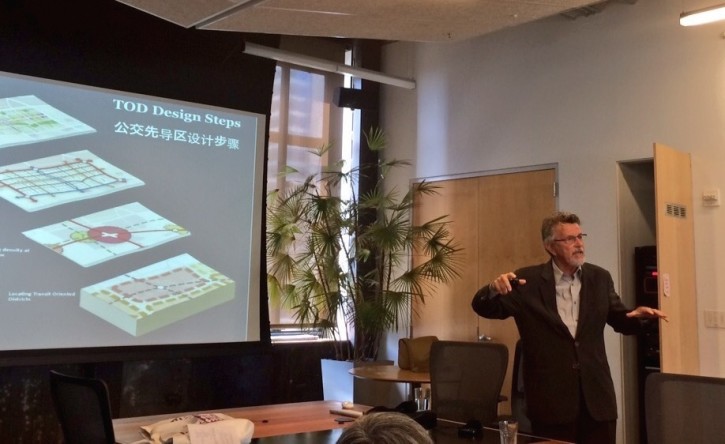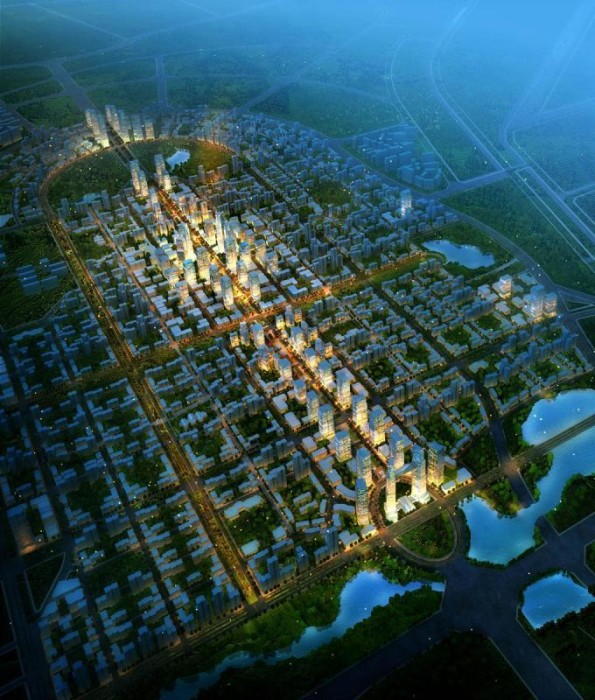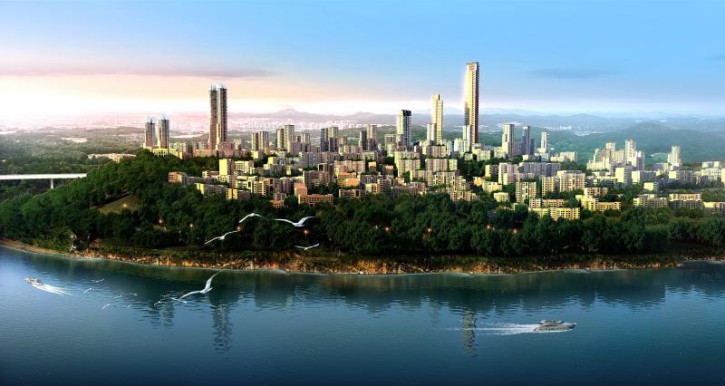By Benjamin Herst

China’s urbanization currently represents “a once in the history of mankind movement,” argues top urban planner Peter Calthorpe to a group of 22 Chinese mayors and urban planning officials in San Francisco. The mayors know that better than most—they are from Zhejiang province, part of China’s intensely-urbanized Yangtze River Delta. As part of the Paulson Institute’s Mayors Training Initiative, the mayors are in the United States for three weeks of intensive training in sustainable urbanization practices.
Calthorpe, who has designed master plans for Portland and other cities worldwide, goes on to describe some of the urban issues he’s encountered in his travels throughout China. Wide boulevards clogged with traffic, super-blocks that discourage pedestrian use, high-rise apartment complexes that deter community-building and uninteresting or inaccessible public spaces—these are just some of the troubles plaguing China’s modern urbanization.
The solution? “Transit-oriented development.” (TOD, for short). A term Calthorpe coined, TOD has come to represent the urban design philosophy of the world’s most advanced urban centers. Rather than embracing the car, TOD encourages development that concentrates residential and commercial space around public transport and provides safe and efficient opportunities for pedestrian and cyclists. “Bikes are the most efficient mode of human transport ever devised,” Calthorpe says. These days, the world’s most advanced economies are transferring away from the car, and increasingly designing urban environments that encourage bikers and pedestrians, according to Calthorpe. Traditionally, the bicycle has figured prominently in Chinese urban transportation, too. But times are changing.
“Every city wants its own Chang’an Avenue,” says Calthorpe, referring to the 10-lane boulevard that bisects central Beijing. As more people enter the middle class and seek to obtain the status symbol of a car, Calthorpe explains, roads get quickly overwhelmed. “When Chinese cities become too crowded, they just build another ring road. Automobile lanes attract more traffic—they will always fill up. Beijing is already on its seventh ring road.”
Can TOD work in China, where the number of motor-vehicles has outpaced road capacity by a factor of nearly six since 1987? Calthorpe thinks so, and his firm is working on two projects that will put that theory to the test.

The first, a master plan for the suburb of Chenggong outside of Kunming, represents the chief expansion zone for a city of over six million people. To prepare for significant growth in the coming years, Chenggong scrapped plans to build superblocks and is experimenting with Calthorpe’s vision of “urban networks.” Calthorpe’s plan for Chenggong includes dense city-blocks featuring mixed-use development, paired one-way street couplets to manage traffic, and a number of auto-free streets, including a central “green spine” that incorporates public park space into a car-free transportation artery.
The second test of Calthorpe’s design ingenuity will come in Yuelai Ecological City, a new development in northern Chongqing, situated within hills and valleys along the Jialing River. The previous designers had planned to level the hills and build a pedestrian-unfriendly development from scratch. But after taking inspiration from San Gimignano, a medieval hill town in central Italy, Calthorpe envisioned a development that overlooked the river and integrated the city into the existing topography. By working with the site’s natural features, Calthorpe sought to maintain the character and identity of the location. In places where steep slopes made walking difficult, plans even called for hillside escalators to facilitate pedestrian mobility.

The conventional wisdom in China these days seems to be that building bigger is the best way to accommodate China’s urban millions. But Calthorpe remains convinced that Chinese cities should still think small, focusing more on transit-oriented development and less on new ring roads. When streets and blocks are built at human-scale, rather than to accommodate cars, Chinese cities more effectively preserve historical urban elements like topography and community.
To prove his point, Calthorpe takes the Chinese delegation on a walking tour of downtown San Francisco, pointing out one-way streets that allow both traffic to flow efficiently and pedestrians to cross safely. As he concludes his tour, Calthorpe issues a challenge to the mayors: “Build no street more than 40 meters wide. It can be done.” With that in mind, perhaps Chinese cities should embrace their past to design for the future.


